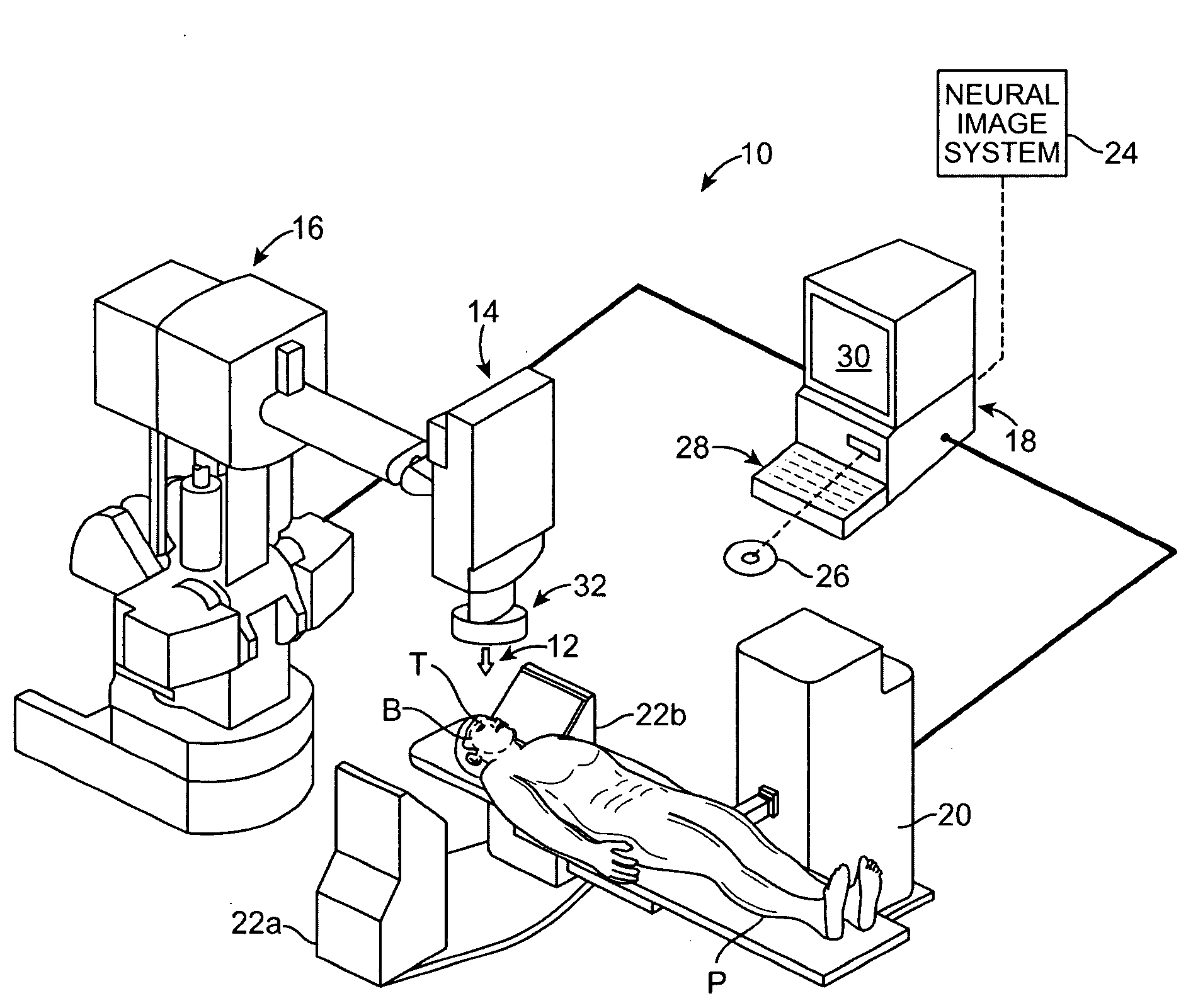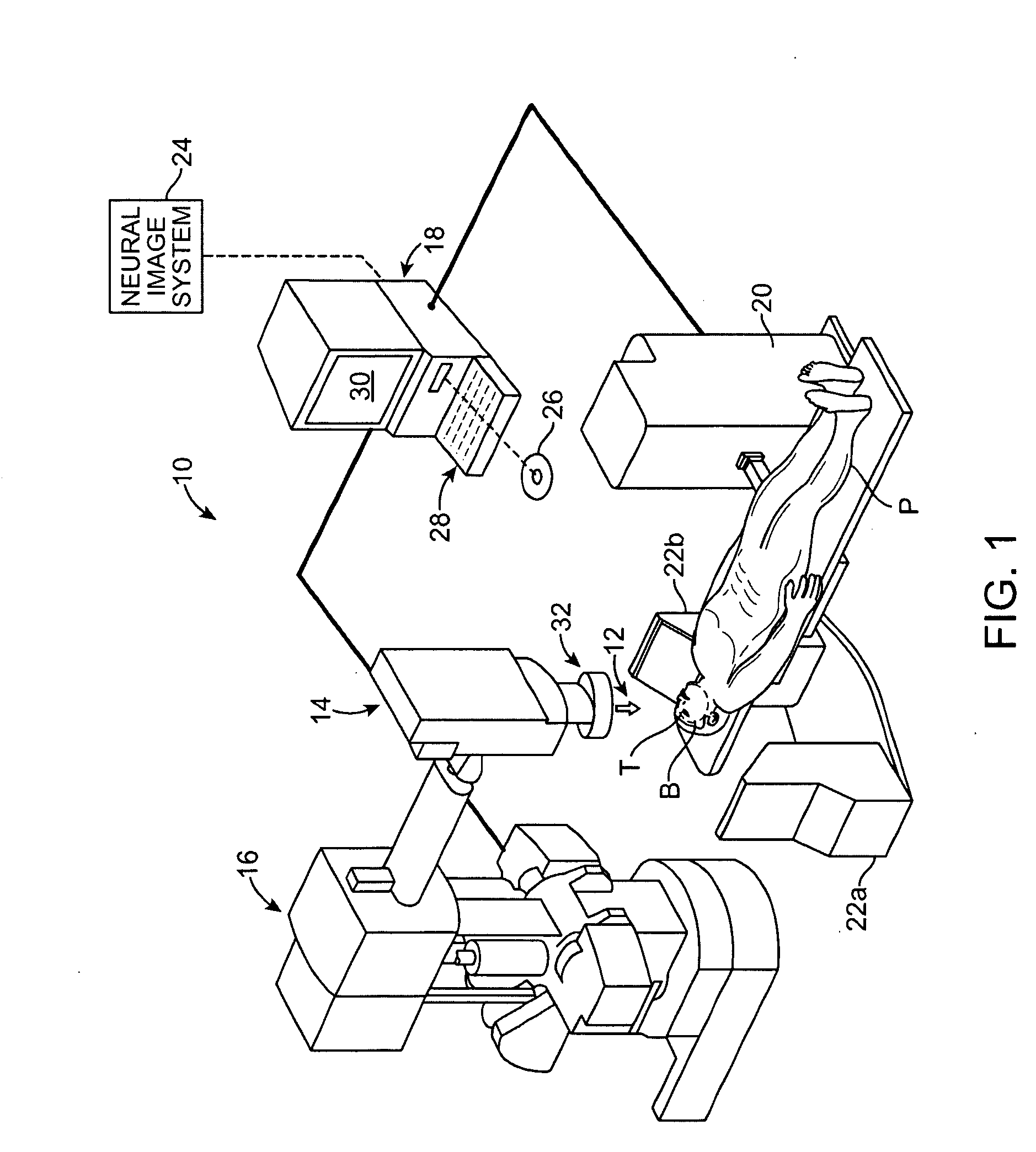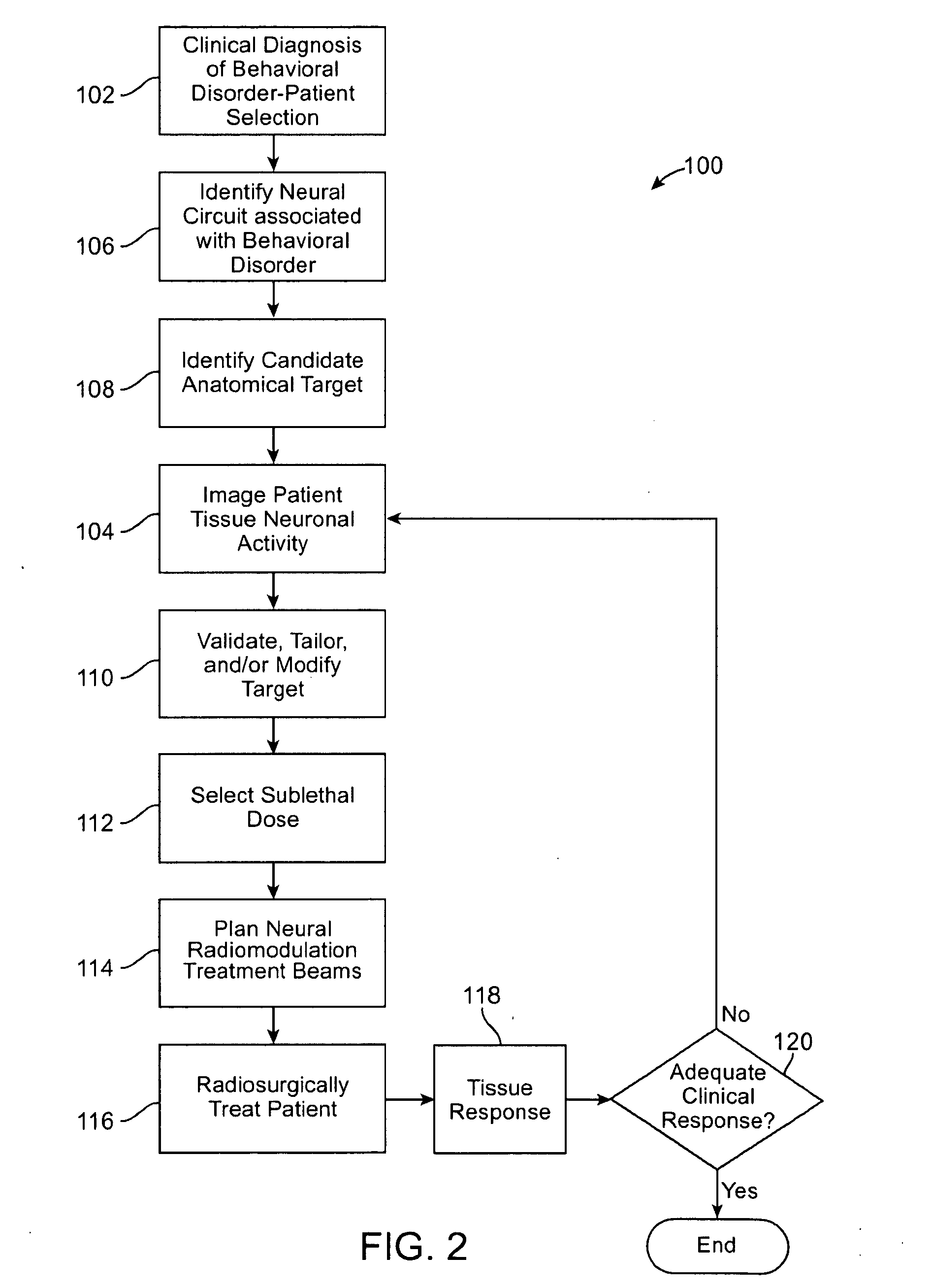[0009]The present invention generally provides improved
medical systems, devices, and methods. Exemplary embodiments of the invention provide improved radiosurgical techniques and systems, particularly for treatment of behavioral disorders (such as depression, Obsessive-Compulsive Disorder (“OCD”),
addiction, hyperphagia, and the like). Related embodiments may be employed for treatment of
obesity. Advantageously, radiation can be directed from a radiation source outside the patient toward a
target tissue deep within the patient's brain using a stereotactic radiosurgical platform, typically without having to impose the surgical trauma associated with accessing deep brain tissues. The target will often be included in a neural circuit associated with the behavioral disorder. Rather than applying sufficient radiation to kill the neural tissue within the target, a cellularly sub-
lethal dose of the radiation may be applied. Without imposing frank
cell death throughout the target, the radiation can mitigate the behavioral disorder, obesity, or the like, often by modulating the level of
neural activity within the target and in associated tissues. Hypersensitive and / or hyperactive neuronal tissue may be targeted, with the radiation downwardly modulating hyperactive neuronal activity. Additionally, by down-regulating the activity of a target that normally exerts
negative feedback or a limiting effect on a relevant neural circuit, the activity of the circuit may be increased.
[0010]In a first aspect, the invention provides a method for treating a psychiatric behavioral disorder or hyperphagia of a patient. The disorder or hyperphagia is associated with a level of neuronal activity in a neural circuit within a brain of the patient, and provokes deleterious volitional behavior by the patient. The method comprises transmitting a sub-lethal quantity of
ionizing radiation from outside the patient into a target within the brain of the patient so as to alter the level of neuronal activity in the neural circuit. By altering the
activity level, the behavioral disorder or hyperphagia is mitigated.
[0011]The neural circuit will typically comprise a recognized behavioral neural circuit that is known to be associated with the behavioral disorder or hyperphagia. A variety of such neural circuits are now known, and more are being developed through the use of imaging techniques which can indicate local neuronal activity levels within the tissues of the brain. Although the overall functioning of the neural circuit is often abnormal prior to treatment of a behavioral disorder patient (for example, with abnormally excessive neuronal activities in some or all of the neural circuit) the neural tissue within the target will often be morphologically normal prior to the treatment, so that the treatment is directed at what may be effectively
healthy tissue. Nonetheless, by selecting an appropriate target within the neural circuit, and by applying a quantity of radiation that is sufficient to decrease the level of neuronal activity within the targeted neural tissue (but which is insufficient to generally kill the tissue of the target), the level of overall activity of the neural circuit may be safely and effectively decreased without excessively (or even significantly) impairing the higher cognitive, emotional, and / or
physical functioning of the patient. Alternatively, where the neural tissue within the target down-regulates the level of neuronal activity within at least a portion of the neural circuit, the radiation may decrease activity in the neural tissue and lead to an increase in the level of neuronal activity within some or all of the neural circuit.
[0012]Advantageously, the target may comprise one or more discrete tissue structure of the brain having anatomical boundaries. The
ionizing radiation can be transmitted from a radiation source as a plurality of radiation beams, and the radiation beams can be planned so that radiation outside the anatomical boundaries drops off sufficiently to inhibit collateral damage to adjacent
neural tissues and preserve cognitive function. As the dosage of radiation even within the target neural tissue is generally cellularly sub-lethal,
necrosis outside the anatomical boundaries of the target may be quite limited or even negligible. The volume of the target will often be quite small, the target typically having a volume of less than 0.5 cc, often having a volume of less than 0.125 cc, and in some cases having a volume of less than 0.06 cc. To facilitate treatment of these small tissue volumes and minimize collateral
tissue damage, some or all of the radiation beams may be smaller in cross-section than those used in standard tumor-treatment stereotactic
radiosurgery. For example, at least some of the radiation beams may be collimated to a beam cross-sectional size of less than 3 mm.
[0015]A variety of functional disorders and other conditions may be treated by directing the radiation to one or more appropriate target(s). One preferred treatment may mitigate a behavioral disorder by targeting Cg25, though a variety of alternative targets may also be selected. For example, depression may be mitigated by targeting a rostral anterior cingulate (rCg24a); a dorsal anterior cingulate (dCg24); Cg 32; and / or a subgenual cingulate (sCg25 or Cg25). Obsessive-Compulsive Disorder (OCD) may be treated by targeting an
internal capsule; BA32; Cg24; a ventral PFC, and / or a dorsal anterior cingulate.
Addiction may be treated by targeting an insula; a genu of the anterior cingulate (BA32); an arcuate
nucleus of a medial
hypothalamus; an anterior cingulate cortex or Brodmann's area 24; an orbitofrontal cortex; a medial
prefrontal cortex; a dorsal anterior cingulate; an anterior limb of an
internal capsule; a
nucleus accumbens; and / or a neural circuit connection between the ventral tegmentum and the
nucleus accumbens. Hyperphagia and / or obesity may be mitigated by targeting a lateral nucleus of a
hypothalamus and / or bilateral nuclei of the
hypothalamus. These and other conditions may advantageously be mitigated by transmitting the radiation from outside the patient, through a
skull and into the brain along beam paths directed from varying directions so as to intersect with the target, often without accessing the target and / or the neural circuit.
[0016]In another aspect, the invention provides a
system for treating a psychiatric behavioral disorder or hyperphagia of a patient. The disorder or hyperphagia can be associated with a level of neuronal activity in a neural circuit within a brain of the patient, and may provoke deleterious volitional behavior by the patient. The
system comprises a source for transmitting ionizing radiation, and a
processing system coupled to the source. The
processing system can be configured to effect transmission of a plurality of beams of the radiation from the source into a target within the brain of the patient. The
processing system can plan the beams so that the radiation within the target has a sub-lethal quantity, but is sufficient to alter the level of neuronal activity in the neural circuit such that the behavioral disorder or hyperphagia is mitigated.
 Login to View More
Login to View More  Login to View More
Login to View More 


